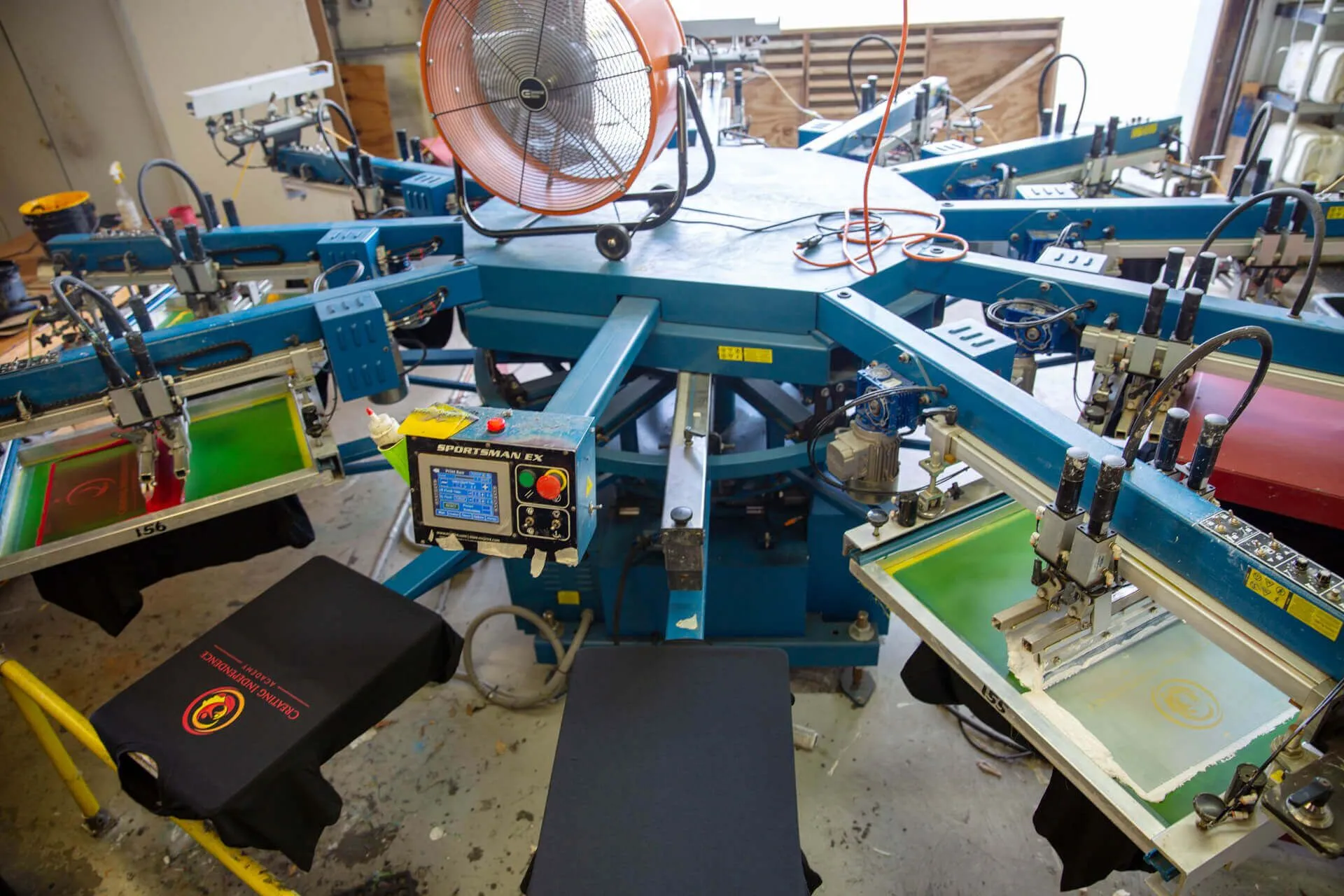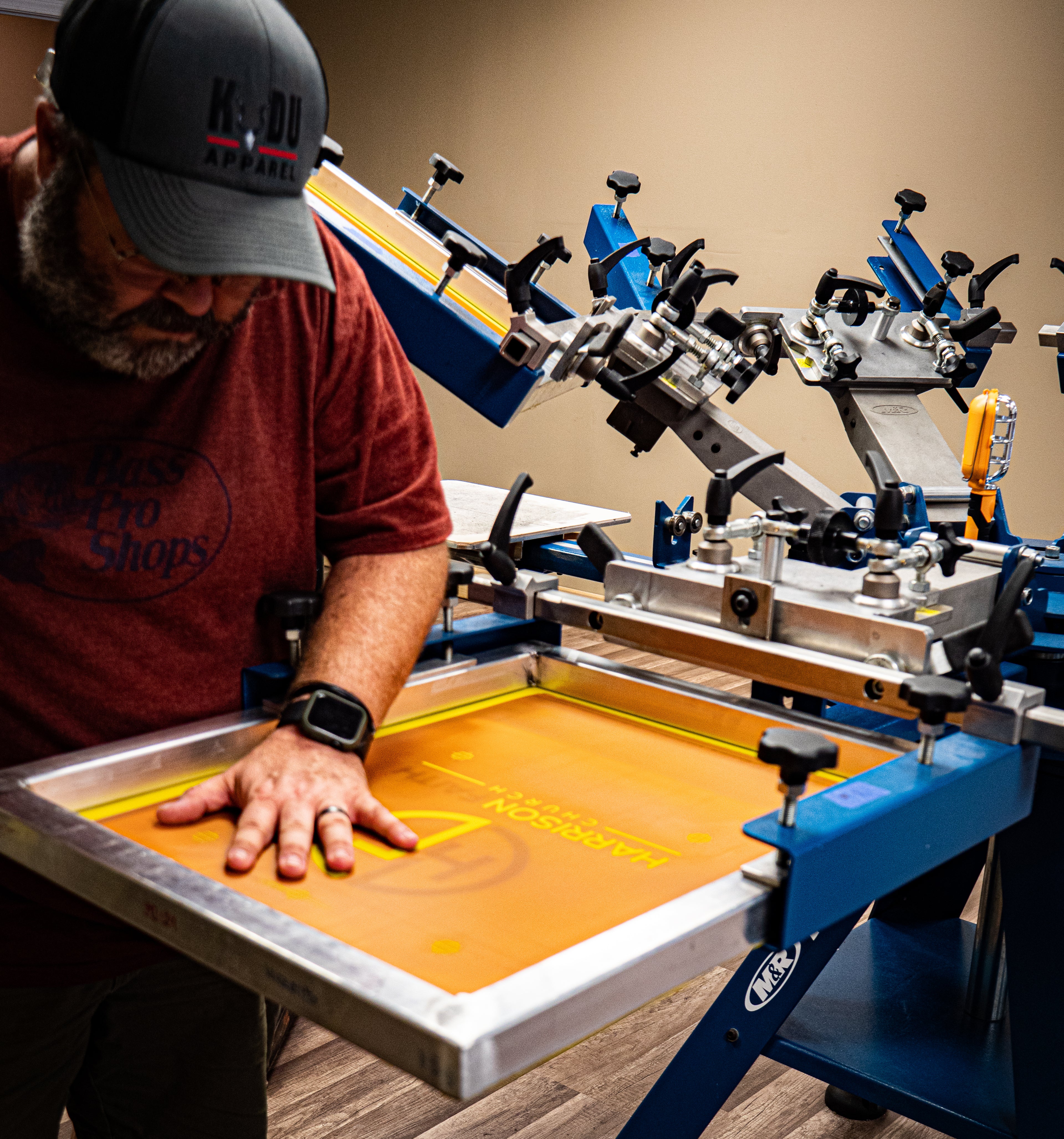Complete Screen Printing Kit for Artists and Creators
Complete Screen Printing Kit for Artists and Creators
Blog Article
Display Printing Uncovered: Everything You Need to Learn About Tee and Garment Printing Methods
If you have actually ever questioned just how those vivid layouts wind up on your favorite tee shirts, you're in the ideal location. Display printing is a remarkable method that combines art with technique, using endless possibilities for creativity. Recognizing the fundamentals, from equipment to ink selections, can greatly affect your outcomes. All set to check out the crucial elements that make screen printing an art kind? Allow's reveal the information that can boost your tasks.
The Basics of Display Printing: How It Works
When you dive right into screen printing, you'll uncover it's both an art and a scientific research. At its core, screen printing entails producing a pattern, or display, that enables ink to pass with just in certain areas.
Next, you'll mix your inks and prepare your printing surface. Placement the screen over the material, after that make use of a squeegee to press ink via the screen onto the garment. This procedure calls for precision, as you desire clear, vivid prints. After printing, you'll treat the ink with heat, guaranteeing it abides by the material and lasts through laundries. Each action is important, and mastering them will certainly boost your display printing skills, changing simple garments into one-of-a-kind, expressive items.
Sorts Of Screen Printing Strategies
When you comprehend the fundamentals of screen printing, it's time to explore the numerous strategies that can elevate your styles. One prominent technique is typical display printing, where ink is pressed with a stenciled screen.
One more option is plastisol printing, understood for its resilience and dazzling colors, making it a preferred for several brand names. Experiment with halftone printing to produce slope impacts and complex styles.
Essential Devices for Display Printing
To accomplish spectacular results in display printing, having the best equipment is essential. You'll need a tough display printing structure, which holds the mesh that transfers your layout onto the garment. Next, invest in top quality mops; these are important for applying ink equally across the screen.
Selecting the Right Inks and Products
When picking inks and products for display printing, you need to consider the kind of ink that works best for your task. Believe regarding textile compatibility to guarantee your styles look last and fantastic lengthy. Check out green ink options to make your printing process more sustainable.
Kinds Of Screen Inks
Picking the right screen ink is essential for attaining dynamic, durable prints that fulfill your job's requirements. There are numerous sorts of screen inks to examine. Plastisol ink is prominent for its convenience and convenience of use, supplying exceptional color opacity on dark fabrics. Water-based ink, on the various other hand, supplies a softer feel and is environmentally friendly, making it optimal for those wanting to decrease their ecological impact. Release inks remove dye from the fabric, leading to a soft, vintage appearance but need particular handling. Specialized inks, such as metal or glow-in-the-dark, can add special impacts to your layouts. Assess your task requirements and select the ink that lines up best with your desired end result.

Fabric Compatibility Considerations
Understanding fabric compatibility is important for accomplishing top notch display prints, especially since various materials respond distinctly to numerous inks. When picking inks, think about the textile kind-- cotton, polyester, or blends. For cotton, water-based inks work well, providing softness and breathability. Polyester, on the various other hand, often calls for plastisol inks for far better bond and dynamic colors. If you're printing on blends, you might require to utilize a combination of both types. Always evaluate your inks on example material to ensure they stick properly and preserve shade stability. Furthermore, remember that material weight and appearance can influence the final end result, so selecting the ideal ink and material combination is important for your project's success.
Eco-Friendly Ink Options
Environment-friendly inks are coming to be a prominent option for display printers that desire to reduce their ecological influence while maintaining quality. When selecting inks, take into consideration water-based inks, which are less damaging and much easier to cleanse up contrasted to traditional solvents.
Furthermore, try to find inks made from eco-friendly sources, such as soy or vegetable-based alternatives. By choosing the best inks and materials, you'll not only create stunning styles however likewise contribute to a more lasting printing procedure. Make the button, and your prints will certainly mirror your commitment to the setting!
Preparing Your Style for Screen Printing

Submit Style Needs
To ensure your style looks sharp and vivid on material, you'll require to pay close interest to read review submit layout requirements for display printing. Make sure your layout has a transparent history to stop undesirable white sides on your prints. Maintain shade settings in mind; CMYK is common for display printing, so transform your RGB creates as necessary.
Color Separation Methods
Shade separation is a necessary action in preparing your design for display printing, and understanding it can considerably improve your print high quality. You'll require to break your layout into specific colors, as each shade needs a different display during printing. This precision not just assures accurate color representation however additionally simplifies the printing process.
Resolution and Dimension
Achieving the most effective outcomes in screen printing begins with guaranteeing your design has the ideal resolution and size. Ideally, your art work must be at the very least 300 DPI (dots per inch) for sharp, clear prints. If you utilize reduced resolution, your final product could look unprofessional and pixelated.
When it concerns size, take into consideration the dimensions of your print area. Layout your artwork to match the final print size, ideally developing it in the real dimensions you'll be publishing. By doing this, you'll avoid any kind of unanticipated scaling problems.
Constantly check your design in both vector and raster formats. Vector graphics can be scaled without losing top quality, making them ideal for screen printing. Preparing properly will assure your design looks amazing on every garment!
Step-by-Step Display Printing Process
Screen printing is a dynamic procedure that permits you to create dynamic styles on different surfaces. To get started, you'll require a screen, emulsion, and your chosen ink.
Put ink onto the screen and utilize a squeegee to press the ink through the pattern onto the material. Lift the screen meticulously and allow the print completely dry. You've efficiently screen published your layout.
Tips for Successful Screen Printing Projects
While you're diving right into your display printing projects, keep in mind that preparation is crucial to success. Begin by collecting all your products-- inks, garments, screens, and mops. A tidy office helps protect against unwanted mistakes, so clean up prior to you begin.
Next, confirm your art work is high-resolution and effectively sized for your garment. Check your display for appropriate exposure and clean see this site it extensively to prevent smudges. When mixing your inks, follow the supplier's guidelines to attain the ideal consistency.
Throughout printing, apply also stress with your squeegee for regular outcomes. Don't hurry; take your time to confirm each print fulfills your criteria. After printing, allow your garments completely dry completely prior to handling or packaging them.
Last but not least, constantly maintain a sample of your work for future referral. This way, you can evaluate your progression and improve your methods with time. Pleased printing!

Often Asked Questions
How much time Does It Require To Establish a Screen Printing Task?
Establishing a display printing job commonly takes around half an hour to an hour. You'll prepare the screens, mix inks, and readjust journalism. The time varies based upon intricacy and experience, so stay arranged!
Can I Publish on Various Fabric Keys In Using the Same Strategy?
Yes, you can publish on different textile kinds using the very same technique, however you'll require to readjust your inks and setups. Some textiles absorb ink in different ways, so trying out warranties the finest results for each material.
What Are Common Mistakes to Avoid in Display Printing?
When display printing, prevent usual errors like making use of the incorrect ink, ignoring proper site here exposure times, or missing pre-press checks. Constantly check your arrangement and keep clean screens to assure high quality outcomes each time.
Just How Can I Correctly Clean and Keep My Display Printing Tools?
To correctly clean and keep your screen printing devices, you should consistently wash displays with proper solvents, inspect squeegees for wear, and guarantee all devices are stored completely dry and dust-free. Uniformity avoids pricey repair services and improves performance.
Is Display Printing Ecologically Friendly Contrasted to Various Other Methods?
Display printing can be more eco-friendly than various other methods, particularly if you make use of water-based inks and eco-conscious materials. By picking sustainable materials and techniques, you decrease waste and minimize your influence on the planet.
Screen Printing Uncovered: Every Little Thing You Required to Know About T-Shirt and Garment Printing Techniques
At its core, display printing involves creating a stencil, or screen, that allows ink to pass with just in details locations. Position the screen over the fabric, then utilize a squeegee to press ink through the display onto the garment. One popular technique is standard display printing, where ink is pressed through a stenciled display.When choosing inks and materials for screen printing, you need to take into account the kind of ink that functions best for your project.
Report this page